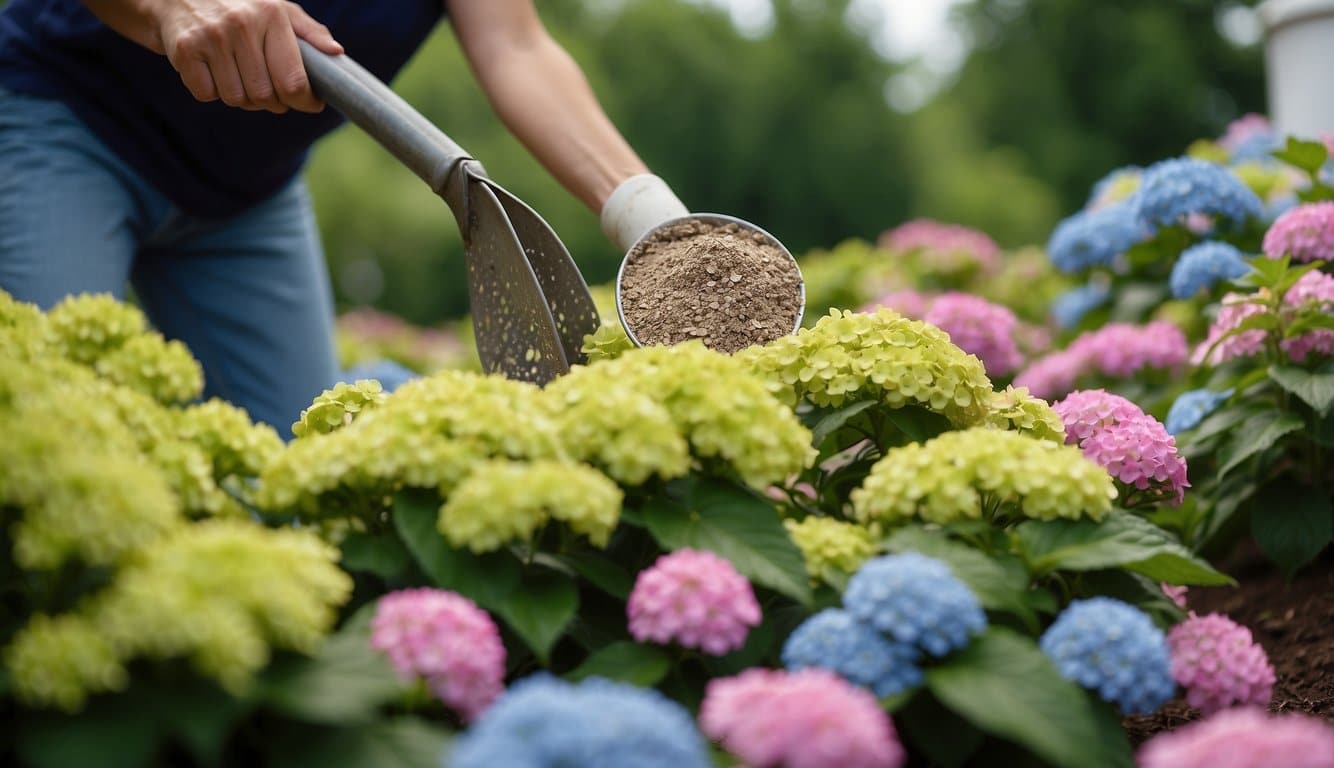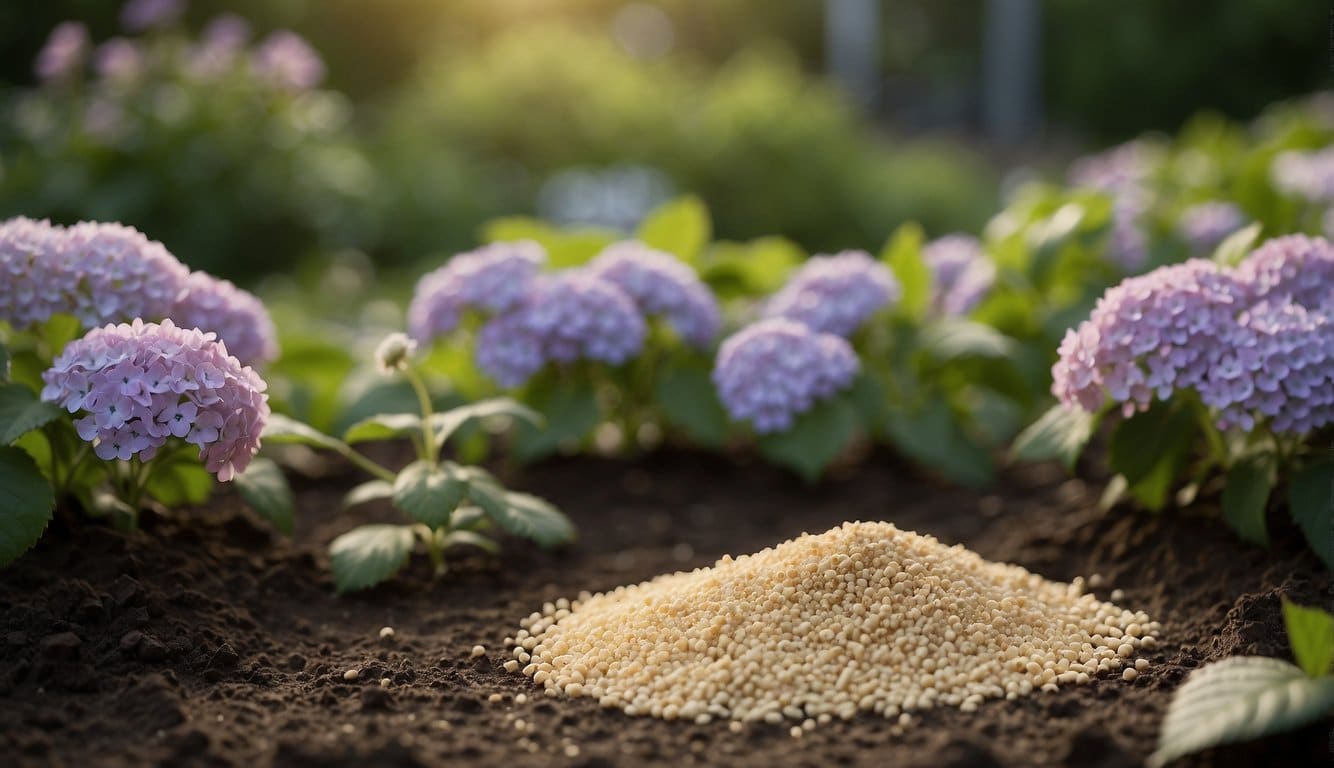Bone meal is a type of organic fertilizer derived from the processed bones of animals. It is commonly used to provide essential nutrients to plants, including hydrangeas. It is especially rich in phosphorus, a mineral that contributes to the root development, growth, and bloom production of many flowering plants.
For hydrangeas—which are known for their impressive and voluminous blooms—bone meal can be particularly beneficial. This is due to its ability to promote a stronger root system and more vibrant blooms.
Applying bone meal to hydrangeas is a practice often recommended for gardeners seeking to enhance the health and beauty of their plants. Since it is a slow-release fertilizer, bone meal provides a steady supply of nutrients over time, helping to maintain the plant’s vitality without the risk of nutrient burn associated with synthetic fertilizers.
Furthermore, in addition to phosphorus, bone meal supplies calcium, another essential nutrient that supports the structural integrity of the plants and improves soil quality. While other fertilizers can be incorporated into a hydrangea care regimen, bone meal stands out for its specific benefits to flowering plants.
Key Takeaways
- Bone meal is a phosphorus-rich organic fertilizer benefiting hydrangeas’ blooms and root systems.
- It offers a slow-release form of nutrition, providing a steady nutrient supply.
- Bone meal additionally contains calcium, improving soil quality and plant structure.
Understanding Bone Meal
Bone meal is an organic fertilizer with a specific nutrient profile beneficial to a variety of plants, including hydrangeas.
The Composition of Bone Meal
Bone meal is primarily made of phosphorous (P), calcium (Ca), and nitrogen (N), with phosphorous being the main component. The typical nutrient ratio of bone meal is 3-15-0, which means it contains 3% nitrogen, 15% phosphorous, and no potassium. The percentages can vary depending on the source of the bone meal.
Benefits for Hydrangeas
Hydrangeas benefit from the phosphorus in bone meal, which promotes the development of strong root systems and healthy flowers. The calcium found in bone meal also supports plant growth and cellular structure. Since hydrangeas are heavy feeders, they respond well to the slow-release properties of bone meal, which ensures they receive a continuous supply of essential nutrients.
Application Guidelines
Bone meal is an organic fertilizer prized for its slow-release phosphorus, vital for healthy hydrangea growth. Proper application ensures that plants receive optimal benefits without damage or waste.
Determining the Right Amount
The amount of bone meal to use for hydrangeas depends on the size of the plant and the nutrient content of the soil. A general guideline is to apply approximately 1 to 2 pounds of bone meal per mature shrub. For reference:
- 1 pound of bone meal = roughly 2.25 cups
It is highly recommended to test the soil before application to tailor the amount to your plants’ specific needs.
Frequency of Application
Bone meal should be applied to hydrangeas:
- Annually, as part of a regular feeding schedule
- Early spring as new growth appears, to support root development and flower formation
- Fall to help plants prepare for winter and ensure a healthy bloom the following season
Applying bone meal more frequently is unnecessary as over-fertilization can lead to an imbalance in soil nutrients.
Best Practices for Using Bone Meal
Applying bone meal fertilizer correctly can significantly enhance hydrangea health and bloom quality. This section delineates the optimal methods for integrating bone meal into hydrangea care.
Soil Preparation
Before adding bone meal, gardeners should ensure their soil is in the right condition to make the most of this organic supplement. Testing the soil pH is crucial, as hydrangeas prefer slightly acidic soil with a pH of 5.5 to 6.5. If the soil is not within this range, amendments may be necessary before applying bone meal to correct pH levels.
- pH Testing: Use a soil pH tester to determine the current acidity or alkalinity.
- Amending Soil: If needed, adjust soil pH using sulfur to lower pH or lime to raise it.
Adequate mixing of bone meal with the top layer of soil helps prevent attracting unwanted pests or rodents. The recommended rate is 1 to 2 pounds of bone meal per established shrub, mixed thoroughly with the top soil.
Combining with Other Fertilizers
While bone meal is an excellent source of phosphorus, hydrangeas benefit from a well-rounded nutrient supply. Gardeners should consider complementing bone meal with other fertilizers to ensure a balanced nutrition profile for their plants.
- Nitrogen: For leaf growth and greenery, nitrogen-rich fertilizers can support overall plant health.
- Potassium: Enhances the plant’s disease resistance and supports stem strength.
- Micronutrients: Trace elements like iron may be necessary based on specific soil deficiencies.
When using multiple fertilizers, follow the instructions for each product carefully to avoid over-fertilization, which can cause harm to the plants. Timing the application of bone meal once in the early spring and combining it with other fertilizers sparingly throughout the growing season can result in a well-fed hydrangea capable of producing vibrant blooms.
Frequently Asked Questions
In caring for hydrangeas, gardeners often question the role and impact of bone meal. This section addresses common inquiries regarding the application, benefits, and specifics of using bone meal for hydrangeas.
How should bone meal be applied to hydrangeas for optimal growth?
Bone meal should be worked into the soil around the hydrangea, ensuring even distribution. It’s commonly advised to incorporate it during the planting phase and as a supplement during the growing season.
What are the benefits of using bone meal as a fertilizer for hydrangeas?
Bone meal provides hydrangeas with essential nutrients, particularly phosphorus for root development, and calcium for strong cell walls, contributing to overall plant health and enhanced blooming.
Can bone meal affect the blooming of hydrangeas, and if so, how?
Yes, bone meal can encourage more prolific blooming in hydrangeas due to its high phosphorus content, which is vital for flower development.
How does bone meal compare to blood meal when used for hydrangea cultivation?
While bone meal is rich in phosphorus and calcium, beneficial for flowering, blood meal provides nitrogen, essential for foliage growth. They serve different purposes and can be used complementary depending on the hydrangea’s needs.
In what quantity should bone meal be used for hydrangeas?
Generally, one to two pounds of bone meal (which is equivalent to approximately 2.25 cups equaling one pound) is recommended for shrubs like hydrangeas, adjusted for plant size and soil conditions.
Are there any specific types of hydrangeas that respond particularly well to bone meal fertilizer?
All types of hydrangeas can benefit from the phosphorus and calcium supplied by bone meal. However, the growth response might vary slightly depending on the specific variety and existing soil conditions.




